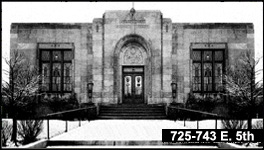 The East Side Branch Library is one of several
free-standing school branch library buildings built by the Gary
Public Library. This building was designed by Joseph Wildermuth.
Architect Wildermuth is also responsible for the design of the
Tolleston Library Branch, the Gary Public Schools Memorial Auditorium,
and the East Chicago Inland Steel Building.
The East Side Branch Library is one of several
free-standing school branch library buildings built by the Gary
Public Library. This building was designed by Joseph Wildermuth.
Architect Wildermuth is also responsible for the design of the
Tolleston Library Branch, the Gary Public Schools Memorial Auditorium,
and the East Chicago Inland Steel Building.
The East Side Branch Library was constructed to serve the "district east of Broadway" - the Emerson Community as well as Emerson School. The building, completed in 1930, was built by H.H. Olney, General Contractor. The structure opened to the public on May 19, 1930.
The branch library is an example of a modern style: Art Deco. The Art Deco style, whose name is derived from a 1925 exhibition, was an artistic movement that existed between World War I and World War II. The movement was a mixture of post-World War I reaction, avant-garde European art styles, the rejection of classical forms, and the introduction of new construction methods and materials.
The building is clad in Indiana limestone and possesses noteworthy ornament and allegories to education and reading books. Various details such as bracketing, shields, and human forms can be found on the building. The entry possess a freeze depicting that "Knowledge is Power."
In the 1996 "Lake County Interim Report: Indiana Historic Sites and Structures Inventory" performed by the Indiana Department of Natural Resources, Division of Historic Preservation and Archaeology (D.H.P.A)," the East Side Branch is listed as "Outstanding." The classification of outstanding is defined as a property "having enough historic or architectural significance that it is already listed, or should be considered for individual listing, in the National Register of Historic Places. "Outstanding" resources can be of local, state, or national importance."
To read a complete assessment and authentication of the building done in 2001, please download the historic structure study entitled, "The East Side Branch Project 725-743 East Fifth Avenue."
Fall 2012 Update: The City of Gary recently demolished this building. The site currently sits as a pile of demolition debris and refuse. Even though this building was listed as an "outstanding" structure in the 1996 Interim Survey of Historic Structures for Lake County, it is interesting to note that this building was grouped among a Section 106 submission containing 17 properties. Per the 1966 Federal Preservation Act and state ordinance, all historic buildings that are scheduled for demolition shall be submitted for a state review process to deem if demolition would cause an adverse affect to the surrounding community. DNR's D.H.P.A Office deemed that this previously classified "outstanding" building has gone through "substantial destruction of interior features due to the extended absence of a roof....concluding that it lacked sufficient interior integrity to be eligible for the National Register." As a result of this standing developed by D.H.P.A, this unique example of Art Deco architecture was allowed to be razed without any consideration that is regularly addressed in National Register properties such as public viewsheds, architectural styling, construction methodologies, cultural history, and materials (such as the exterior envelope that contained various types of ornamentation rendered in Bedford limestone, vitreous block interior construction, cellular steel roof supports, Art Deco styling, etc.). Again the lack of preservation resource management on both the local and state level has again taken place in Gary, Indiana.
Gone now are the decorative spandrel panels, allegories to reading and education, the entry freeze, an interior space that had potential for reuse, and this last surviving Gary example of Art Deco. All of these activities have been paid for via federal tax dollars provided by the Department of Housing & Urban Development in the form of Community Block Grant Funding. As public funds are being utilized, the City of Gary needs to provide a more transparent and improved public involvement process as these decisions are using limited tax payer dollars and the decisions rendered are affecting the livelihood and economic standing of the city.
If a preservation resource plan is not developed, the City of Gary is on track to loose many important buildings that are worthy for adaptive reuse and sustainable redevelopment. The current city administration professes "green urbanism" but to date not one single project, such as reusing an historic building, has materialized for the tax payers of the city.
With continued loss of significant historic fabric and noteworthy buildings, the City of Gary is setting itself up to loose out on prevailing national trends of urban reinvestment and new urbanism. With the demolition of the East Side Branch Library another loss and another empty lot is now placed on the backs of Gary citizens and taxpayers. All of this happening within a city that once drew nationally-known architects and planners.
